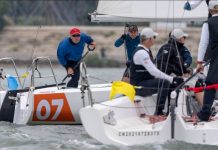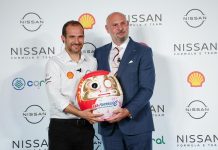Glorious year 1955: Silver Arrows win a spate of victories
60 years ago, the Mercedes-Benz Silver Arrows were practically unbeatable throughout the entire racing season – in all the major classes of international motor sport.
In 1955, the Stuttgart racing team with Juan Manuel Fangio at the wheel of the W 196 R won the Formula 1 world championship for the second time running and achieved a triumph in the sports car world championship with the 300 SLR (W 196 S).
Werner Engel became European touring car champion in the 300 SL (W 198) production sports car. Major national titles were also won, for example victory in Class D of the US sports car championship.
The public and the motor racing world celebrated Mercedes-Benz for this uniquely successful season, as no manufacturer had previously dominated the international racing events of one year so comprehensively.
This was due to a combination of innovative technology, a highly motivated team and meticulous planning and organisation.
This attitude by the Mercedes-Benz racing team is aptly illustrated by one example: the legendary “Blue Wonder”, a 160 km/h fast racing car transporter developed by Mercedes-Benz in 1955 as a one-off for particularly urgent conveyance of racing cars between the factory, the racetracks, and for practice sessions.
1955: highlight of a glorious development process
The preparations for the triumphs by the Silver Arrows 60 years ago already began in 1952, when Mercedes-Benz re-entered the international racing scene with the 300 SL racing sports car and won numerous victories.
The excitement grew dramatically in 1954, immediately after Mercedes-Benz had returned to Grand Prix racing, when Juan Manuel Fangio won the world championship by a wide margin at the wheel of the new W 196 Silver Arrow.
In the 1955 season, Mercedes-Benz brought this development process to full fruition. Apart from Fangio it was above all Stirling Moss who shone in the new 300 SLR racing sports car.
The excellent results gave rise to great expectations for the 1956 racing season, however even before the 1955 season ended, the Executive Board of the then Daimler-Benz AG decided that until further notice, Mercedes-Benz would withdraw from motor sport after that season.
The reason was the company’s accelerated development of new passenger car and commercial vehicle series. This meant that there was an urgent need for skilled personnel who were currently committed to the motor sport activities.
After all, at the high point of the 1955 season the racing department employed more than 200 personnel and was able to call on other in-house specialists when needed.
The message was clear: the creativity, innovative strength and expertise of the engineers and technicians who had helped the Mercedes-Benz racing cars to achieve their victories were now to be devoted to development for series production.
For the Silver Arrows, their drivers and the entire racing department, this meant saying goodbye to the world of international motor racing – at the height of their success and to tumultuous applause.
A mysterious new engine for the new Silver Arrow
It was already clear in mid-January that the 1955 motor sport season was likely to be a particularly successful year for Mercedes-Benz: improved even further since the 1954 season, the W 196 R competed in the Argentine Grand Prix in Buenos Aires, the first Formula 1 race in the 1955 calendar.
Juan Manuel Fangio, world champion in the previous year driving a Mercedes-Benz Silver Arrow, emerged as the winner of this hot, gruelling race in his home country after superhuman efforts. But Mercedes-Benz also had another appointment in Argentina: on 30 January, the Silver Arrows lined up at the start of the non-formula Buenos Aires Grand Prix.
Fangio was the winner ahead of Stirling Moss, with Karl Kling taking 4th place.
In this race, the Silver Arrows were powered by a new three-litre engine which the engineers had developed from the 2.5-litre, eight-cylinder power unit of the Formula 1 racing car. This was the engine that came to be used in the new 300 SLR (W 196 S) racing sports car.
However, this car with its muscular, streamlined bodywork, which was developed by Mercedes-Benz to win the battle for the world sports car championship, only had its official racing debut at the Mille Miglia three months later.
Series of world championship victories in Formula 1
In Formula 1 – as in the previous year – Mercedes-Benz placed its confidence mainly in classic racing cars with exposed wheels. All in all there were three different variants of the W 196 R body design for 1955 (the “R” stood for “Racing” to distinguish it from the sports car, which bore an “S” in its name).
The major difference between them was the wheelbase. A fully enclosed racing car similar to the streamlined variant with which Mercedes-Benz had opened the 1954 racing season was not used until the Italian Grand Prix, the last Formula 1 race of 1955.
Following a moderate performance in the Monte Carlo Grand Prix in Monaco (also the European Grand Prix), the Belgian Grand Prix began a breathtaking series of three double victories for Mercedes-Benz (each time with Fangio in 1st place) and a quadruple victory for the Silver Arrows in the British Grand Prix in Aintree, Lancashire, (Moss followed by Fangio, Kling, and Piero Taruffi).
This meant that after a disappointing start in Monaco, Mercedes-Benz won all subsequent Formula 1 races of the 1955 season. This is because the Grand Prix races in Germany, France, Spain, and Switzerland were cancelled following the tragic accident during the Le Mans 24-hour race in June.
Fangio won the Formula 1 driver’s title with 40 points ahead of Stirling Moss (23 points). This was the second world championship title in succession for the Mercedes-Benz racing driver and his W 196 R, and his third championship title overall.
Mercedes-Benz 300 SLR: the star of the 1955 racing season
The Mercedes-Benz brand itself did not win a title in the 1955 Formula 1 season, despite its outstanding success record (a total of five victories, four 2nd places and one 3rd place in seven races).
This is because the drivers’ world championship title was awarded from the start in 1950, but the constructors’ championship was only introduced in 1958.
This made the company’s commitment to the 300 SLR for the world sports car championship, where the title went to the most successful constructor, all the more important.
The new racing sports car, whose technology was closely related to that of the Formula 1 car, had its debut in the Mille Miglia. Stirling Moss with his co-driver Denis Jenkinson won probably the most gruelling road race of the era in the best time ever set in the Mille Miglia.
It took the pair 10 hours, 7 minutes and 48 seconds to cover the distance of around 1,600 kilometres. This equates to an average speed of 157.62 km/h.
Fangio, driving with no co-driver, crossed the finishing line in 2nd place just 31 minutes and 45 seconds later – likewise an outstanding performance.
In this 1,000-mile race from Brescia to Rome and back, the Stuttgart-based brand also demonstrated that the sporting excellence of Mercedes-Benz cars extended from thoroughbred racing cars to regular production saloons.
In addition to the overall victory by the 300 SLR, the production models 300 SL (W 198) and 180 D (W 120) were the winners in their respective classes.
After the double victory (Fangio ahead of Moss) in the International Eifel Race at the Nürburgring, the 300 SLRs were at the starting line for the Le Mans 24-hour race in June. Here the car driven by the blameless Mercedes-Benz driver Pierre Levegh was involved in the worst accident ever to have occurred in motor racing history.
Out of respect for the victims and in consultation with senior management, racing manager Alfred Neubauer decided to withdraw the leading 300 SLRs from the race. This made the pressure to win the remaining races even greater.
Final decision in the last race
Indeed, in the International Tourist Trophy in Dundrod, Northern Ireland, the penultimate race of the world sports car championship, the 300 SLR triumphed by taking the first 3 places. What was still needed for the title were the points from the Sicilian classic, the Targa Florio.
This was a heart-stopping final event, for Mercedes-Benz had only taken part in three of the five races conducted so far, and Ferrari was in the lead by a few points. The Mercedes-Benz team needed a victory to secure the title, and also needed to ensure that its competitors Ferrari and Jaguar only achieved a 3rd place at most.
Even under this immense pressure, Mercedes-Benz was able to continue its series of victories and emerged triumphant with 1st place for Moss and Peter Collins, 2nd place for Fangio and Kling and 4th place for Desmond Titterington and John Cooper Fitch.
This final success secured the title, and the Mercedes star of the racing department shone more brightly than ever before.
Race-winners: the Mercedes-Benz cars of the 1955 season
The racing cars and racing sports cars of the W 196 series
In 1954, Mercedes-Benz returned to Grand Prix racing with a completely newly developed racing car. The W 196 R – the “R” stood for Racing – complied with all the conditions of the new Grand Prix formula of the CSI (Commission Sportive Internationale): a displacement of 750 cubic centimetres with supercharger or 2,500 cubic centimetres without, no restrictions on fuel composition.
The 300 SLR racing sports car (W 196 S – the “S” standing for Sport) was developed in parallel with this model, and was first used in the 1955 season which it proceeded to dominate.
The two cars shared a technical concept consisting of the following components: a spaceframe (introduced in the 300 SL racing sports car in 1952), a transaxle configuration with the five-speed transmission positioned behind the differential, a single-link swing axle with a low pivot point at the rear and – with two exceptions – inboard drum brakes plus the use of torsion bar springs and telescopic shock absorbers.
In both, the racing car and the racing sports car, the frame and suspension excelled with forgiving handling characteristics which proved particularly outstanding on demanding, difficult and wet road surfaces.
The frame structure impressed with its great torsional rigidity and robustness, contributing to driver safety in accidents or when leaving the road unintentionally. Especially in difficult driving conditions, the newly developed single-link swing axle produced superior handling characteristics.
As an overall package, these technical innovations were almost a guarantee of victory. In the 1955 season, from the British Grand Prix in Aintree, Lancashire, on 16 July onwards, the Formula racing cars were equipped with engageable auxiliary springs designed to keep the wheel camber and suspension at a constant level as the contents of the full fuel tank decreased.
For the M 196 engine the designers opted for new technologies that had not been used in previous Mercedes-Benz racing cars. These included desmodromic valve control, which reliably allowed high engine speeds – this was not achievable with the previous spring-controlled valves.
Another innovation was direct petrol injection, which Mercedes-Benz was introducing into series production with the 300 SL “Gullwing” (W 198) at the same time. This allowed more efficient metering of the fuel to suit the load and performance requirements, while at the same time lowering fuel consumption compared with previous designs.
The eight-cylinder in-line engine consisted of two adjoined four-cylinder steel blocks with a central power take off. The variant used for Formula 1 with a displacement of 2,496 cc initially developed 188 kW (256 hp) at 8260 rpm in 1954, increasing to 213 kW (290 hp) at 8,500 rpm in 1955. A major part of the power increase was due to ongoing improvements and the straight intake manifolds introduced for the 1955 season.
The higher position of the pressure pipe caused by the straight intake manifolds made a cowl necessary on the right-hand side of the bonnet – a distinguishing feature of the 1955 racing cars. The engine had a compression ratio of 1:11, and could only be operated on special methanol-based racing fuel.
The eight-cylinder engine of the 300 SLR racing sports car distinguished itself from the Formula 1 engine by a displacement increased to 2,982 cc, two cylinder housings of cast aluminium rather than cast steel, and the reversed camshaft rotation. It generated up to228 kW (310 hp) at 7,500 rpm.
The compression ratio was only 1:9, so that normal premium petrol could be used in accordance with the rules for the world sports car championship.
Mercedes-Benz also tested this engine in the W 196 R for a racing event, namely the non-formula race on 30 January 1955 in Buenos Aires, Argentina. In contrast to its later use in the 300 SLR, the compression ratio was increased to 1:11 on this occasion.
Streamlined body or exposed wheels
The concept for the new W 196 R Formula 1 racing car also included the use of two different light-alloy bodies, which had already been planned for the pre-war racing cars and which were selected according to the racetrack. The chassis was given a streamlined body for high-speed circuits. A body with exposed wheels was used for circuits with numerous bends – a configuration that Juan Manuel Fangio for example particularly liked because he could exactly determine the position of the front wheels.
For the racing debut of the W 196 R, the French Grand Prix in Reims on 4 July 1954 in Reims (France), streamlined racing cars were provided for all three drivers because the circuit allowed very high speeds. Juan Manuel Fangio and Karl Kling drove to an epoch-making double victory – on the same day when the German national football team achieved the “wonder in Berne” and won the World Cup.
The young Hans Herrmann was the third in this perfect trio for a long time, and even achieved a lap record, but was later forced to retire with engine damage.
The classic monoposto with exposed wheels was used for most of the Formula 1 races of 1954 and 1955. This variant had its debut at the Nürburgring on 1 August 1954, where it won the European Grand Prix.
Once again the winner was Juan Manuel Fangio. The W 196 R with exposed wheels was available in three different wheelbases for the 1955 season, so as to have the ideal car for any racetrack. This was accompanied by different brake configurations. In the case of the racing cars with a medium and long wheelbase, the engine was moved rearwards and allowed space for large drum brakes located inboard next to the wheels.
This space was not available in the version with a short wheelbase, as the engine was positioned further forward, and the front wheel brakes were accommodated outboard within the wheels.
All in all there were therefore four variants of the W 196 R, which were used to suit the relevant race circuit. The result of all this technical effort and excellent race organisation was this: the Mercedes-Benz racing car was the most successful car in the 1954 and 1955 seasons by a wide margin – and it was in this Silver Arrow that Juan Manuel Fangio won the Formula 1 world championship in both years.
300 SLR – the dominant racing sports car of the 1955 season
From the very start Mercedes-Benz dominated the world sports car championship races of the 1955 season with the 300 SLR (W 196 S), and secured the hotly contested title – the car was far superior to all its competitors.
This success by the 300 SLR was due to the outstanding technical basis it shared with the Formula 1 racing cars. This close relationship gave the racing sports car superior roadholding, a highly reliable engine and – not least owing to the strong spaceframe – a robustness that was unusual for a sports car.
One special feature was the so-called air-brake, which was used in the Le Mans 24-hour race and in the Swedish Grand Prix. This enabled the driver to manually extend a metal plate into the airstream. This ensured much improved deceleration compared with using the drum brakes alone – and not only thanks to the significantly higher air resistance, but also owing to the additional downforce at the rear axle.
The plate normally lay flat against the bodywork, and was hinged at the rear edge. The driver deployed it hydraulically by operating a hand lever.
The results achieved by the Mercedes-Benz 300 SLR remain unsurpassed to this day: It won every race in which it competed and finished.
It demonstrated its absolute superiority with double victories in the Mille Miglia, the Eifel Race, the Swedish Grand Prix and the Targa Florio – and the 300 SLRs even brought off a triple victory in the International Tourist Trophy. An eternal record was also established by Stirling Moss and his co-driver Denis Jenkinson with their victory in the 1955 Mille Miglia: they won the race at a still unbeaten average speed of 157.65 km/h.







































